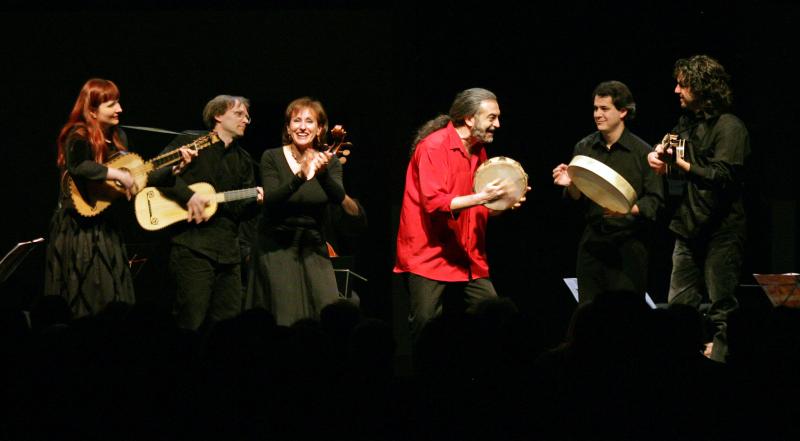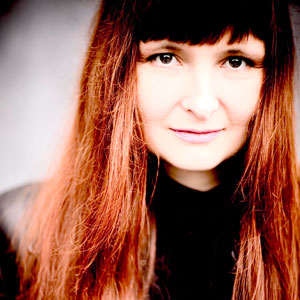L'Arpeggiata, Wigmore Hall | reviews, news & interviews
L'Arpeggiata, Wigmore Hall
L'Arpeggiata, Wigmore Hall
An evening of Mediterranean warmth and sensuality from baroque's very best

L’Arpeggiata are everything that crossover should be and everything that this arranged marriage of genres so often isn’t. The work of lutenist Christina Pluhar and her band of period musicians is organic and authentic, a blend of musics that amplify and enrich one another, a conversation between friends and equals.
After a too-lengthy drought of UK appearances (save one token visit to the Proms last year), L’Arpeggiata are at last back. Last night’s concert was only the first in a residency at the Wigmore Hall that will take us all the way through to next July, giving the group’s British audiences the chance to catch up on several years of back-catalogue.
Athough a male soprano, Capezutto's is not a contorted, classically-trained voice, but a natural curiosity
A lapping of percussion “waves” and the sigh of wind in “trees” launched us into music from Mediterraneo, the most recent disk from an ensemble whose every release finds them trying on a different stylistic personality for size. Which isn’t to say there’s no coherence. Whether experimenting with jazz-renaissance fusion, exploring European folk songs or dances through the ages, there’s a level of energy (and a pulsing ground bass) that marks the music out as L’Arpeggiata’s creation.
Southern Italy was our musical home for this evening, and dancer Anna Dego and singers Raquel Andueza and Vincenzo Capezzuto (who also proved that he knows his way around a pirouette) our guides. Folksongs from Puglia, cradle songs and tarantellas – the dance of death provoked by the bite of the tarantula – made for an evening of contrasts, all woven together into sustained musical narratives by Pluhar. Bringing us up with lively instrumental ciacconas and into more contemplative space with love songs, the group transformed an orderly midweek concert into a fluid narrative of emotion. No interval and almost no pauses for applause broke the mood, and only the rigidly bourgeois architecture of the Wigmore prevented us kicking aside shoes and losing ourselves in the holiday spirit of it all.
 Capezzuto is an extraordinary performer. A male soprano, his is not a contorted, classically-trained voice, but a natural curiosity. It has all the guilelessness of a pop voice with none of the vulgarity. Duets Tres Sirenas and Are mou rineddha were crooned with plangent ease, but the elastic androgyny of the instrument really came into its own in the punchier, more rhythmic numbers Pizzicarella mia and Lo Passariellu.
Capezzuto is an extraordinary performer. A male soprano, his is not a contorted, classically-trained voice, but a natural curiosity. It has all the guilelessness of a pop voice with none of the vulgarity. Duets Tres Sirenas and Are mou rineddha were crooned with plangent ease, but the elastic androgyny of the instrument really came into its own in the punchier, more rhythmic numbers Pizzicarella mia and Lo Passariellu.
Perhaps the best bits of any L’Arpeggiata concert are the improvisations. Laying down a ground bass (a riff by any other name) the group then take it in turns to step forward for jazz-style breaks. Jazz might have come down to us via Africa but I defy anyone to hear a Purcell or Monteverdi ground and not trace the natural genealogy. Pluhar (pictured right) here makes her case without effort as we marvel at plucked bass and drums or – most impressive – a percussion solo for the finest wizard of percussion David Mayoral, giving us a single skin that can shriek, cry or sing according to the strokings of his fingers.
Adding a wonderful strangeness to L’Arpeggiata’s textures is the psaltery, a strung instrument a bit like a zither played with hammers rather than fingers. Together with the virtuosic cornetto (used here both as jazz trumpet and saxophone substitute, and played with astonishing skill by Doron Sherwin) the psaltery offers a characterful treble line over the deeper pluckings of theorbo, guitar and baroque harp. The unusual instrumentation transforms warm, rich southern European textures with an uncanny, silvered sound-quality, as though the music itself is faded under the bright contemporary lights.
The main body of the concert over, L’Arpeggiata returned to transform an already-familiar tune one stage further. From baroque to jazz was well-trodden territory, but to rap? It says so much for the complete conviction of the band that this last musical metamorphosis not only passed the cringe test but once again exposed a family tree of styles much closer together than we might instinctively place them. Surprise, irreverence and so much joy. L’Arpeggiata have given themselves a lot to live up to.
- L'Arpeggiata return to the Wigmore Hall for concerts on 21 March and 10 July 2014
rating
Explore topics
Share this article
Add comment
The future of Arts Journalism
You can stop theartsdesk.com closing!
We urgently need financing to survive. Our fundraising drive has thus far raised £49,000 but we need to reach £100,000 or we will be forced to close. Please contribute here: https://gofund.me/c3f6033d
And if you can forward this information to anyone who might assist, we’d be grateful.

Subscribe to theartsdesk.com
Thank you for continuing to read our work on theartsdesk.com. For unlimited access to every article in its entirety, including our archive of more than 15,000 pieces, we're asking for £5 per month or £40 per year. We feel it's a very good deal, and hope you do too.
To take a subscription now simply click here.
And if you're looking for that extra gift for a friend or family member, why not treat them to a theartsdesk.com gift subscription?
more Classical music
 Echo Vocal Ensemble, Latto, Union Chapel review - eclectic choral programme garlanded with dance
Beautiful singing at the heart of an imaginative and stylistically varied concert
Echo Vocal Ensemble, Latto, Union Chapel review - eclectic choral programme garlanded with dance
Beautiful singing at the heart of an imaginative and stylistically varied concert
 Scott, Irish Baroque Orchestra, Whelan, RIAM, Dublin review - towards a Mozart masterpiece
Characteristic joy and enlightenment from this team, but a valveless horn brings problems
Scott, Irish Baroque Orchestra, Whelan, RIAM, Dublin review - towards a Mozart masterpiece
Characteristic joy and enlightenment from this team, but a valveless horn brings problems
 Classical CDs: Voice flutes, flugelhorns and froth
Baroque sonatas, English orchestral music and an emotionally-charged vocal recital
Classical CDs: Voice flutes, flugelhorns and froth
Baroque sonatas, English orchestral music and an emotionally-charged vocal recital
 Kanneh-Mason, Britten Sinfonia, Shave, Milton Court - a grin and a big beaming smile
A pair of striking contemporary pieces alongside two old favourites
Kanneh-Mason, Britten Sinfonia, Shave, Milton Court - a grin and a big beaming smile
A pair of striking contemporary pieces alongside two old favourites
 theartsdesk at the New Ross Piano Festival - Finghin Collins’ musical rainbow
From revelatory Bach played with astounding maturity by a 22 year old to four-hand jazz
theartsdesk at the New Ross Piano Festival - Finghin Collins’ musical rainbow
From revelatory Bach played with astounding maturity by a 22 year old to four-hand jazz
 First Person: Manchester Camerata's Head of Artistic Planning Clara Marshall Cawley on questioning the status quo
Five days of free events with all sorts of audiences around Manchester starts tomorrow
First Person: Manchester Camerata's Head of Artistic Planning Clara Marshall Cawley on questioning the status quo
Five days of free events with all sorts of audiences around Manchester starts tomorrow
 Goldscheider, Brother Tree Sound, Kings Place review - music of hope from a young composer
Unusual combination of horn, strings and electronics makes for some intriguing listening
Goldscheider, Brother Tree Sound, Kings Place review - music of hope from a young composer
Unusual combination of horn, strings and electronics makes for some intriguing listening
 theartsdesk Q&A: composer Donghoon Shin on his new concerto for pianist Seong-Jin Cho
Classical music makes its debut at London's K-Music Festival
theartsdesk Q&A: composer Donghoon Shin on his new concerto for pianist Seong-Jin Cho
Classical music makes its debut at London's K-Music Festival
 Helleur-Simcock, Hallé, Wong, Bridgewater Hall, Manchester review - moving lyricism in Elgar’s concerto
Season opener brings lyrical beauty, crisp confidence and a proper Romantic wallow
Helleur-Simcock, Hallé, Wong, Bridgewater Hall, Manchester review - moving lyricism in Elgar’s concerto
Season opener brings lyrical beauty, crisp confidence and a proper Romantic wallow
 Kohout, Spence, Braun, Manchester Camerata, Huth, RNCM, Manchester review - joy, insight, imagination and unanimity
Celebration of the past with stars of the future at the Royal Northern College
Kohout, Spence, Braun, Manchester Camerata, Huth, RNCM, Manchester review - joy, insight, imagination and unanimity
Celebration of the past with stars of the future at the Royal Northern College

Comments
You don't make a single